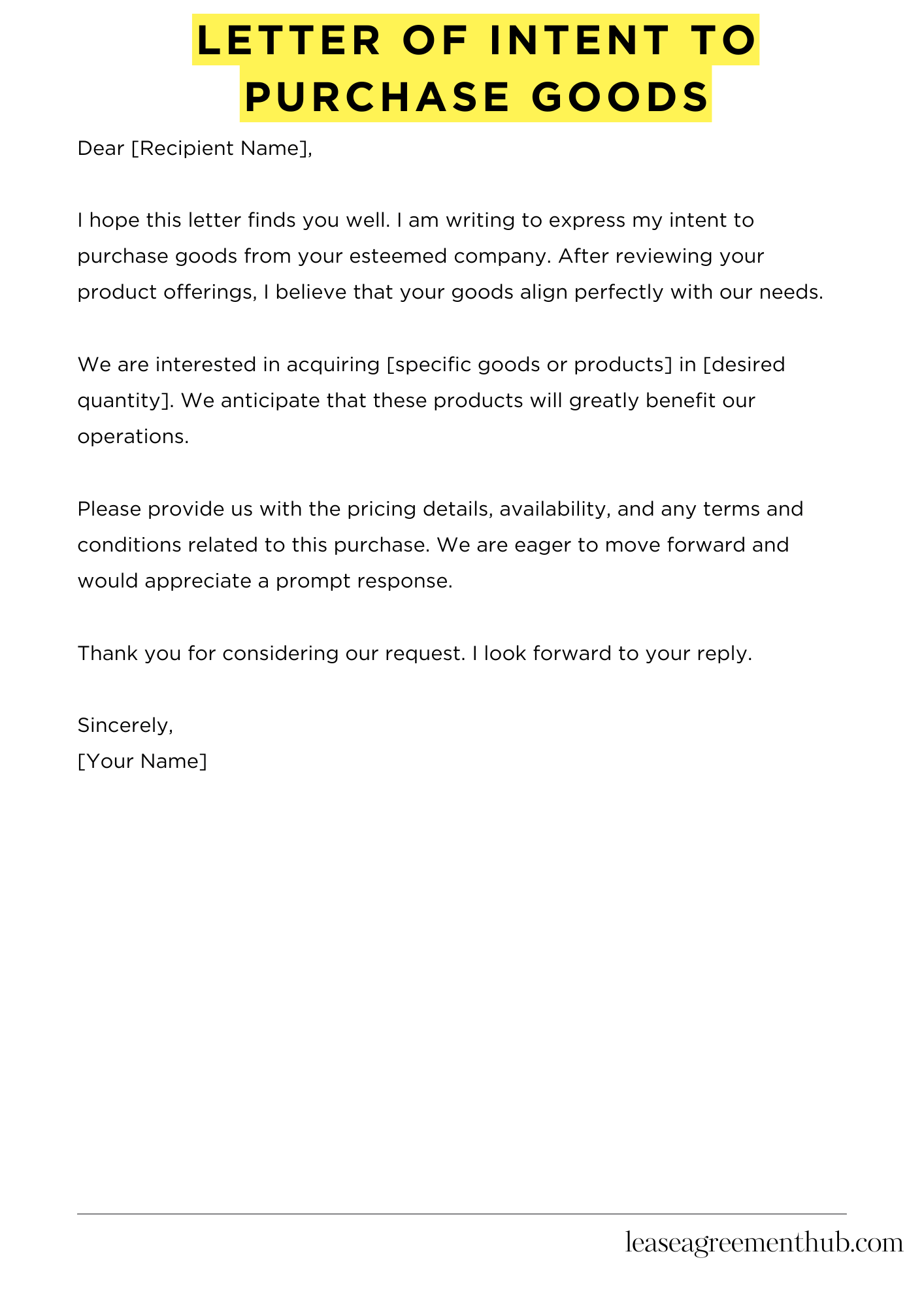A Letter of Intent to Purchase Goods is a document that outlines a buyer’s intention to buy specific products from a seller. It serves as a formal way to express interest and initiate negotiations. This letter can help both parties clarify terms and expectations before a final agreement is made.
In this article, we will provide various templates and examples of Letters of Intent to Purchase Goods. These samples are designed to make it easier for you to create your own letter. Whether you are a business owner or an individual, these templates will guide you in writing a clear and effective letter.
By using our examples, you can save time and ensure that your letter covers all necessary details. This will help you communicate your intentions clearly and professionally. Let’s dive into the samples and get started on your Letter of Intent.
Letter Of Intent To Purchase Goods
[Your Name]
[Your Address]
[City, State, Zip Code]
[Email Address]
[Phone Number]
[Date]
[Recipient Name]
[Recipient Title]
[Company Name]
[Company Address]
[City, State, Zip Code]
Dear [Recipient Name],
I hope this letter finds you well. I am writing to express my intent to purchase goods from your esteemed company. After reviewing your product offerings, I believe that your goods align perfectly with our needs.
We are interested in acquiring [specific goods or products] in [desired quantity]. We anticipate that these products will greatly benefit our operations.
Please provide us with the pricing details, availability, and any terms and conditions related to this purchase. We are eager to move forward and would appreciate a prompt response.
Thank you for considering our request. I look forward to your reply.
Sincerely,
[Your Name]

How to Write a Letter of Intent to Purchase Goods
A Letter of Intent (LOI) to purchase goods is a crucial document in any business transaction. It’s a formal expression of your interest in acquiring specific goods from a seller. It outlines the key terms and conditions of the potential purchase, serving as a preliminary agreement before finalizing the deal. This article will guide you through crafting an effective LOI that clearly communicates your intentions and sets the stage for a successful transaction.
1. Start with a Clear and Concise Introduction
Begin your LOI with a clear and concise introduction. State your purpose, which is to express your intent to purchase specific goods from the seller. Identify the goods you’re interested in and mention any relevant details, such as quantity, specifications, and desired delivery date. This sets the tone for the rest of the document and ensures the seller understands your intentions from the outset.
2. Outline the Key Terms and Conditions
The heart of your LOI lies in outlining the key terms and conditions of the proposed purchase. This section should include:
- Purchase Price: Clearly state the agreed-upon price for the goods.
- Payment Terms: Specify the payment method, schedule, and any applicable discounts or financing options.
- Delivery: Outline the delivery date, location, and any associated shipping costs.
- Warranty: Mention any warranties or guarantees offered by the seller.
- Inspection: Specify whether you require the opportunity to inspect the goods before finalizing the purchase.
Be as detailed as possible to avoid any misunderstandings later on.
3. Specify the Duration and Conditions of the LOI
Your LOI should have a defined duration, indicating how long it remains valid. This period allows both parties time to negotiate and finalize the details of the purchase. Additionally, include any conditions that must be met before the LOI can be considered binding. For example, you might require the seller to provide specific documentation or complete a certain task within a specified timeframe.
4. Include a Clear Statement of Intent
Conclude your LOI with a clear statement of your intent. Reiterate your desire to purchase the goods and your commitment to proceeding with the transaction if the terms are agreeable. This section serves as a final confirmation of your intentions and helps set the stage for further negotiations.
5. Review and Proofread Carefully
Before sending your LOI, review it carefully for any errors or omissions. Ensure all information is accurate, complete, and clearly presented. Proofread for grammar and spelling mistakes. A well-written and error-free LOI reflects professionalism and demonstrates your commitment to the transaction.
Remember that an LOI is a legally binding document, so it’s essential to consult with legal counsel if needed. By following these steps, you can craft a comprehensive and effective LOI that sets the foundation for a successful purchase agreement.
Related: